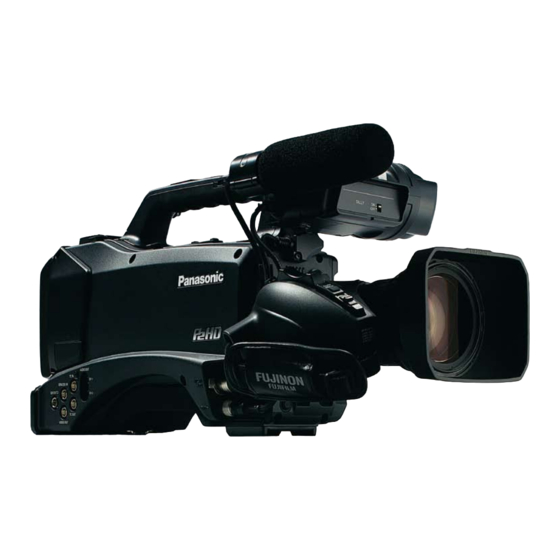Panasonic AG-HPX370 Brochure & Specs - Page 9
Browse online or download pdf Brochure & Specs for Camcorder Panasonic AG-HPX370. Panasonic AG-HPX370 21 pages. Ag-hpx370 series memory card camera recorder p2hd

Selectable DVCPRO HD Recording
The AG-HPX370 series also supports the conventional DVCPRO HD
codec. Because the AG-HPX370 series are designed to be used with the
AG-HPX170 series/HVX200A series or a DVCPRO HD VTR, it adapts to
a variety of system configurations.
Sample Images of Intraframe Preduction
Intra-Frame (I-Frame Only) Compression Superiority
Motion-image compression can be divided roughly into two methods: I-Frame
Only compression, which completes all processing within each frame, and
Long GOP compression, which processes across multiple frames. AVC-Intra
and DVCPRO HD use I-Frame Only compression, while HDV uses Long GOP
compression.
The MPEG-4 AVC/H.264 standard encompasses both methods.
When the images of adjacent frames are similar, Long GOP compression
achieves an advantageously low bit rate. However, this trait is not often seen
in broadcasts like flash-filled press conferences, fast-action sports, and video
with rapid move and electronic displays. Also, because processing is
performed frame-by-frame in I-Frame Only, new-generation multi-core CPUs
offer high-speed parallel processing. This makes I-Frame Only compression
more suitable for nonlinear editing than Long GOP, for which parallel
processing is difficult due to its inter-frame dependence. With its I-Frame Only
compression, AVC-Intra produces remarkably stable images that are
unaffected by adjacent frames, and meets professional needs in virtually all
situations and workflows.
A V C - I n t R A t E C h n O L O g y
Left: Original image Center: Intra-frame predictive image Right: Difference image obtained from
subtracting the intra-frame predictive image from the original image. This shows the high accuracy of
intra prediction.
48-kHz/16 bit, 4-Channel Digital Audio
The AG-HPX370 series can record full 48-kHz/16 bit digital audio on all
four channels. You can freely select the audio source for each channel,
choosing from mic-in, line-in and wireless receiver.
Twice the Compression Efficiency of MPEG-2
By selecting the most effective compression techniques from among those in
compliance with the H.264 standard, AVC-Intra has doubled the compression
ratio of MPEG-2, even with I-Frame Only compression. Its intraframe
predictive and context-adaptive entropy coding are particularly effective
methods for boosting compression efficiency.
Intraframe predictive coding (intra prediction)
This process generates predictive images based on adjacent blocks of 8 x 8
pixels. Selecting the most suitable predictive mode from among nine
luminance signal modes (see illustration) and four color signal modes, it
generates accurate predictive images. The residual data (obtained by
subtracting a predictive image from the original input image) is recorded
together with the predictive image. Because the prediction accuracy is high,
there's minimal residual data, and thus high compression is achieved. This
process is conducted within the frame, so prediction accuracy remains high
even with fast-motion images.
mode 0
mode 1
mode 2
mode 4
mode 5
mode 6
Adjacent pixels
Predictive pixels
Copy of below pixel
mode 8
Context-adaptive entropy coding
The entropy coding process used in MPEG-4 AVC/H.264 utilizes CAVLC
(Context Adaptive VLC) and CABAC (Context Adaptive Binary Arithmetic
Coding), both of which are context adaptive. MPEG-2 uses a fixed table when
performing the VLC coding, with the result that compression efficiency is low
with some types of images. In context-adaptive coding, on the other hand,
operation varies with different kinds of images and high compression
efficiency is maintained at all times.
Average
mode 3
mode 7
